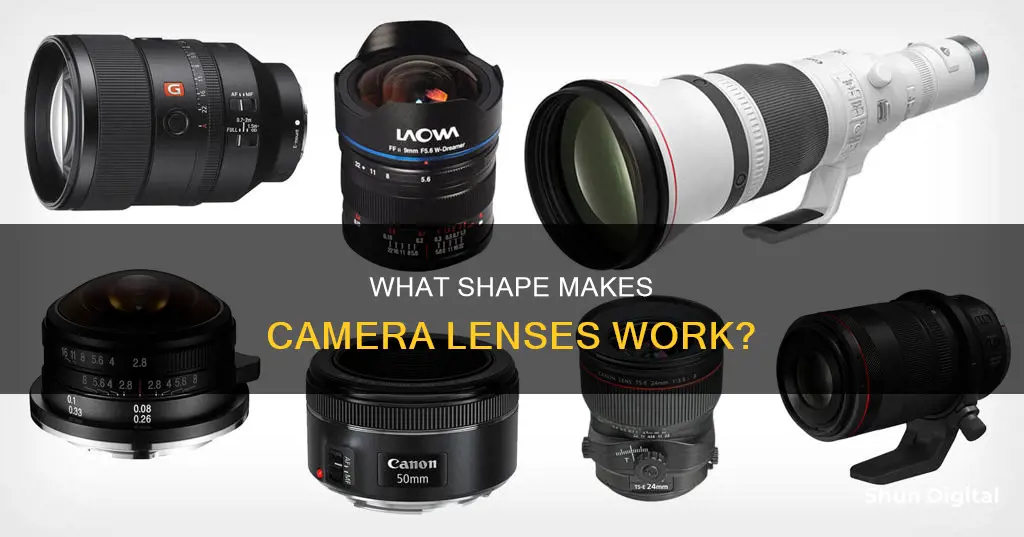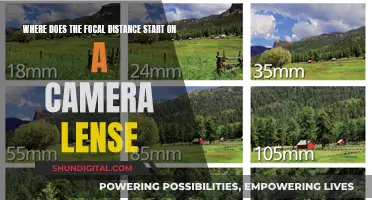
The camera lens is an essential component of a camera, responsible for bringing objects into focus by refracting light rays. Lenses can be broadly categorized into two types: concave and convex. Concave lenses are thinner in the middle and thicker at the edges, while convex lenses are thicker in the middle and diverge towards the edges. Both types of lenses are used in the manufacture of camera lenses, and they serve different purposes. The primary lens of a camera is typically convex, but combining it with a concave lens can improve image quality by reducing distortions and aberrations. This combination is commonly used in telephoto and zoom lenses to enhance the optical performance of the camera.
| Characteristics | Values |
|---|---|
| Lens type | Convex and concave |
| Lens elements | Multiple |
| Image | Real |
| Image plane | Upside down |
| Image quality | Distortions and blurs |
| Lens shape | Convex is thicker in the middle; concave is thicker at the edges |
| Light rays | Convex converges; concave diverges |
| Lens function | Convex used for farsightedness; concave for nearsightedness |
| Lens combination | Convex and concave used together to improve image quality |
What You'll Learn

Camera lenses are usually convex
Convex lenses are used in a range of optical devices, including cameras, telescopes, microscopes, and eyeglasses. In the case of cameras, the convex lens is the primary lens and is responsible for bringing the light rays to a point of focus on the image plane (the image sensor or film at the back of the camera).
The use of a convex lens in cameras is important because it allows for the formation of a real image on the screen. A concave lens, on the other hand, does not form a real image. However, both convex and concave lenses are used in combination in camera lenses to improve image quality and eliminate distortions.
The combination of convex and concave lenses in a camera lens serves to correct issues such as chromatic aberration, where light of different colours is refracted at different angles, creating a fringe effect around bright objects in the picture. By using both types of lenses, these undesirable effects can be minimised, resulting in sharper and more accurate photographs.
Thailand Camera Gear: Are Lenses a Bargain?
You may want to see also

Concave and convex lenses are often used together in cameras
Lenses play a crucial role in the optical magic of photography, bringing a subject into focus on the image plane. Both convex and concave lenses are used in the manufacture of photographic lenses for various reasons, including aberration reduction and the function of telephoto and zoom lenses.
Convex lenses are thicker at the centre than at their edges. They converge light rays, bending them inwards and focusing them on a point on the other side of the lens known as the focal point. This is the same type of lens used in the human eye to bring objects into focus.
Concave lenses, on the other hand, are thicker at the edges than in the centre. They diverge light rays, refracting them outwards so that they appear to merge at a point in front of the lens, which is also known as the focal point.
Combining a single convex lens with a single concave lens enables distant objects to be seen in more detail. This combination of lenses is used in telephoto lenses, with the concave lens placed upfront to refract light, followed by the convex lens, which turns the light rays parallel, magnifying the object. A final concave lens at the back condenses the light rays, resulting in a simple telephoto lens.
By adding another set of convex and concave lenses along with a mechanism to adjust the distance between the lens pairs, you can create a telephoto zoom lens. This allows for the modification of magnification over a continuous range, which is the principle behind zoom lenses.
In summary, both concave and convex lenses play important roles in the construction of photographic lenses, working together to correct aberrations, enable zoom functions, and produce sharp, detailed images in cameras.
Best Places to Sell Your Camera Lenses Online
You may want to see also

Convex lenses converge light rays
Convex lenses are thicker in the middle and thinner at the edges. They are also known as converging lenses because they bend parallel light rays inwards and converge them at a point known as the focal length. This is the reason why they are the most sought-after lenses for manufacturing photographic lenses.
The photographic lens is what creates the optical magic of bringing a subject's image into focus on the image plane (the image sensor or photographic film at the back of the camera). It refracts light rays, condenses them, and brings them to focus. The photographic lens is responsible for all the magic that happens inside a camera.
Convex lenses are used in eyeglasses to correct farsightedness, where the distance between the eye's lens and retina is too short, resulting in the focal point being behind the retina. Eyeglasses with convex lenses increase refraction and reduce the focal length.
Convex lenses are also used in magnifying glasses, cameras, and the correction of hypermetropia. They are the most common type of lens and are essential in the construction of photographic lenses.
When light rays pass through a convex lens, they bend, changing their direction. This causes objects seen through the lens to appear bigger or smaller than they actually are because the rays seem to come from a different point. The focal point of a convex lens is determined by bending rays of light passing through the lens inward, resulting in the rays meeting in the focal spot.
Understanding Camera Lens Interchangeability: What You Need to Know
You may want to see also

Concave lenses diverge light rays
Lenses are broadly divided into two types: convex and concave. Concave lenses are thicker at the edges and thinner in the middle. Rays of light that pass through a concave lens are spread out and diverge.
When parallel rays of light pass through a concave lens, the refracted rays diverge so that they appear to come from one point called the principal focus. This point lies in front of the lens and is the point on the axis of the incoming light from which the spread light beam appears to originate.
The ability of a lens to converge or diverge light rays depends on its geometry. Concave lenses diverge light rays because they are thinner in the middle. The light rays that pass through the lens are refracted and spread out.
Convex lenses, on the other hand, are thicker in the middle and converge light rays. When parallel rays of light pass through a convex lens, the refracted rays converge at a point called the principal focus. This is the opposite of what happens with concave lenses.
Both convex and concave lenses are used in the manufacture of photographic lenses for various reasons, including the reduction of aberration and the function of telephoto and zoom lenses.
Camera Kit Lenses: Worth the Money or Worthless?
You may want to see also

Convex lenses are used to correct farsightedness
Lenses are broadly divided into two types: convex and concave. Convex lenses are thicker at their centres than their edges, while concave lenses are the opposite, thicker at the edges than the centre. Convex lenses are used to correct farsightedness, or hypermetropia, a condition where the distance between the eye's lens and retina is too short, resulting in the focal point lying behind the retina.
Convex lenses are able to correct this issue by increasing refraction and reducing the focal length. This allows the image to be formed on the retina of the eye. In essence, convex lenses converge light, bending it inwards, and making objects look larger and farther away. This is in contrast to concave lenses, which diverge light, bending it outwards, and making objects look smaller and closer.
Convex lenses are widely used in prescription glasses and photographic lenses. In the simplest form, a photographic lens would be made using a single convex lens. However, this simple design is rarely used in practice due to issues with producing a perfectly focused image. Instead, multiple convex and concave lenses are combined to correct issues such as spherical and chromatic aberrations.
Convex lenses are also used in other optical devices, such as telescopes. For example, the Galilean telescope combines a single convex lens with a concave lens, allowing distant objects to be seen in more detail.
Anti-Camera Lenses: Worth the Investment?
You may want to see also
Frequently asked questions
Convex lenses are thicker at the middle, while concave lenses are thinner at the middle and thicker at the edges. Convex lenses converge light rays, while concave lenses diverge them.
The primary lens of a camera is a convex lens.
Using a combination of concave and convex lenses helps improve the quality of photographs. A convex lens alone can cause distortions in photographs called chromatic aberrations. Combining a convex lens with a concave lens eliminates this effect.
A simple telephoto lens is made by combining a convex lens with a concave lens. The front convex and concave lens serve to magnify the image, while the rear convex lens condenses it.







